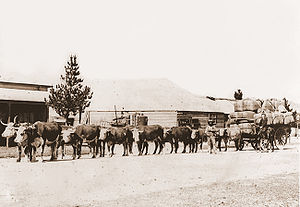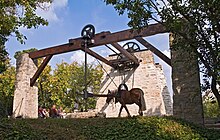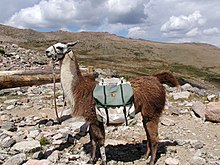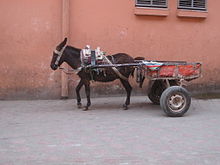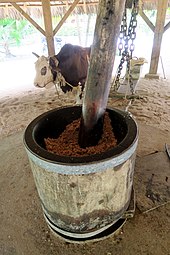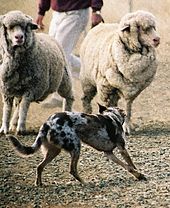
The Siberian Husky is a medium-sized working sled dog breed. The breed belongs to the Spitz genetic family. It is recognizable by its thickly furred double coat, erect triangular ears, and distinctive markings, and is smaller than the similar-looking Alaskan Malamute.

A cart or dray is a vehicle designed for transport, using two wheels and normally pulled by draught animals such as horses, donkeys, mules and oxen, or even smaller animals such as goats or large dogs.

A sled dog is a dog trained and used to pull a land vehicle in harness, most commonly a sled over snow.

A working dog is a dog used to perform practical tasks, as opposed to pet or companion dogs.

A herding dog, also known as a stock dog or working dog, is a type of dog that either has been trained in herding or belongs to breeds that are developed for herding. A dog specifically trained to herd sheep is known as a sheep dog or shepherd dog.

A pack animal, also known as a sumpter animal or beast of burden, is an individual or type of working animal used by humans as means of transporting materials by attaching them so their weight bears on the animal's back, in contrast to draft animals which pull loads but do not carry them.
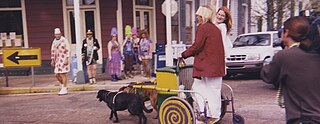
Carting is a dog sport or activity in which a dog pulls a dogcart filled with supplies, such as farm goods, camping equipment, groceries or firewood, but sometimes pulling people. Carting as a sport is also known as dryland mushing and is practiced all around the world, often to keep winter sled dogs in competition form during the off-season.

A detection dog or sniffer dog is a dog that is trained to use its senses to detect substances such as explosives, illegal drugs, wildlife scat, currency, blood, and contraband electronics such as illicit mobile phones. The sense most used by detection dogs is smell. Hunting dogs that search for game, and search and rescue dogs that work to find missing humans are generally not considered detection dogs but instead under their own categories. There is some overlap, as in the case of cadaver dogs, trained to search for human remains.

Skijoring is a winter sport in which a person on skis is pulled by a horse, a dog, another animal, or a motor vehicle. The name is derived from the Norwegian word skikjøring, meaning "ski driving". Although skijoring is said to have originated as a mode of winter travel, it is currently primarily a competitive sport.

Weight pulling is a dog sport involving a dog pulling a cart or sled loaded with weight a short distance across dirt/gravel, grass, carpet, or snow. It is a modern adaptation of freighting, in which dogs were used as freight animals to move cargo.

The domestication of vertebrates is the mutual relationship between vertebrate animals including birds and mammals, and the humans who have influence on their care and reproduction.

Tracking refers to a dog's ability to detect, recognize and follow a specific scent. Possessing heightened olfactory abilities, dogs, especially scent hounds, are able to detect, track and locate the source of certain odours. A deeper understanding of the physiological mechanisms and the phases involved in canine scent tracking has allowed humans to utilize this animal behaviour in a variety of professions. Through domestication and the human application of dog behaviour, different methods and influential factors on tracking ability have been discovered. While tracking was once considered a predatory technique of dogs in the wild, it has now become widely used by humans.

Dogs in warfare have a very long history starting in ancient times. From being trained in combat, to their use as the scouts, sentries, messengers, mercy dogs, and trackers, their uses have been varied and some continue to exist in modern military usage.

Animals in sport are a specific form of working animals. Many animals, at least in more commercial sports, are highly trained. Two of the most common animals in sport are horses and dogs.
The following outline is provided as an overview of and topical guide to transport:

Driving, when applied to horses, ponies, mules, or donkeys, is a broad term for hitching equines to a wagon, carriage, cart, sleigh, or other horse-drawn vehicle by means of a harness and working them in this way. It encompasses a wide range of activities from pleasure driving, to harness racing, to farm work, horse shows, and even international combined driving.

The Yakutian Laika is an ancient working dog breed that originated in the Arctic seashore of the Sakha (Yakutia) Republic. Yakutian Laikas are multipurpose laikas, with many lineages able to herd reindeer, hunt game and/or pull a sled. They are registered with the Russian Kennel Club, the FCI and the AKC's Foundation Stock Service in 2017.

Backpacking with animals is the use of pack animals, such as a horse, llama, goat, dog, or donkey to help carry the weight of a backpackers gear during an excursion. These animals need special considerations when accompanying backpackers on a trip. Some areas restrict the use of horses and other pack animals. For example, Great Basin National Park does not allow domestic animals at all in backcountry areas.
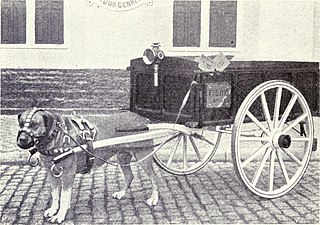
A drafting dog, pulling dog, or draft dog is a dog bred and traditionally used for pulling a dogcart, or in winter also for sled pulling. Dogs bred for this work have strong builds. Many draft dogs are either mastiffs or of livestock guardian descent, both of which are dogs that are solidly-built.
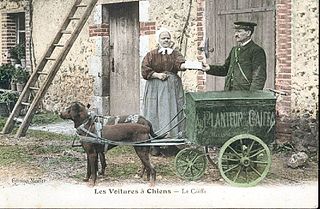
A dog harness is a piece of equipment consisting in part of straps that surround the dog’s torso. It is used to guide, hold, and lift the dog or to utilise its pulling power. It reduces tension on the neck when they pull, and provides free breathing during daily walks. In sports such as mushing and skijoring, where the dog's pulling power is utilized, the harness provides effective use of force while maintaining freedom of movement. These aforementioned kinds of harnesses differ from pet harnesses in that they are specifically designed in order to allow or support a dog in the completion of a working task.
